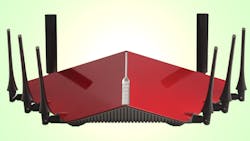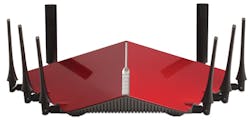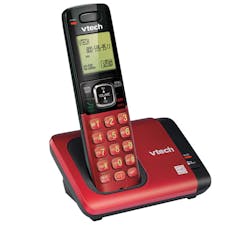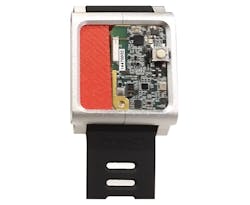The Internet of Things (IoT) implies connectivity, and developers have lots of wired and wireless options at their disposal to make it happen. Ethernet tends to dominate the wired realm. IoT frameworks map higher-level protocols on this type of connectivity, but the devices don’t work until they have a method of communication with the network.
This file type includes high resolution graphics and schematics when applicable.
At this point, Ethernet implementations range from 10 Mb/s up to 100 Gb/s. Of course, the high end generally targets the backbone of the Internet to link server farms in the cloud, while the low to midrange runs on the rest of the devices. The median implementation these days is 1-Gb/s Ethernet.
Legacy devices reside in the low end, namely 10- and 100-Mb/s Ethernet. Low-end microcontrollers, especially ones with built-in Ethernet controllers, also can be found here. The typical low- to mid-range Ethernet switch handles 10/100/1000-Mb/s Ethernet. These gigabit switches work with just about any device by handshaking to find a compatible speed and protocol. Protocols can be quite complex, including details like quality-of-service (QoS), flow control, and virtual private network (VPN) support. These are often transparent to IoT developers working at the TCP/IP protocol level or higher.
Though 10-Gb/s Ethernet is gaining ground, especially for mid-range server interconnect, a new class of Ethernet speeds looms on the horizon. Essentially, 1-Gb/s Ethernet is bumping up to 2.5 Gb/s with a corresponding hop up for higher-speed Ethernet like 10 Gb/s moving to 25 Gb/s. This change essentially provides faster throughput using the same cabling.
With Ethernet essentially serving as the backbone for wireless communication, wireless access points of various flavors have an Ethernet port that’s typically faster than the wireless side. As a result, the wireless link can operate at full speed. Multiple access points usually exist in a commercial or industrial setting, with a single Ethernet backbone connecting them together as well as providing a link to the Internet when appropriate.
Wi-Fi Delivers Bandwidth
Wi-Fi, with its array of 802.11 variants, provides the highest throughput of wireless technologies at this point. It started with 802.11a and b, and progressed to 802.11ac. The 802.11b standard had a raw data rate of 11 Mb/s and only utilized the 2.5-GHz band, while 802.11ac uses the 2.5- and 5-GHz bands with a combined bandwidth of 5.3 Gb/s. Indoor range is on the order of 100 to 200 feet. The next evolution—802.11ax—is poised to succeed 802.11ac.
One example of the latest in Wi-Fi routers comes from D-Link (Fig. 1). The AC5300 handles speeds up to 5.3 Gb/s. The system, driven by a 1.4-GHz dual-core processor, features eight antennas for MIMO (multiple-input, multiple-output) support.
The challenge with 802.11 concerns spectrum utilization. Anyone trying to use Wi-Fi at a tradeshow has run into the problem of spectrum over-utilization. For example, a show’s 2.5-GHz band has 11 channels (depending on the country), but the channels overlap and that can actually reduce data bandwidth for all parties. Non-overlapping layouts of multiple access points normally use channels 1, 6, and 11. Though access points on the same channel can coexist through negotiation, data bandwidth is limited.
Wireless protocols incorporate security standards. The 802.11 Wired Equivalent Privacy (WEP) has been broken and should not be used, since it’s generally limited to older 802.11b platforms. The Wi-Fi Protected Access (WPA) and 802.11i, also known as WPA2, are the security protocols of choice these days. Open wireless access points can operate with no security protocols.
A key challenge for IoT developers surrounds power requirements. Not so much for wireless devices with wired power or sufficient battery resources, but rather for mobile devices like smartphones and tablets. Still, Wi-Fi is often the choice for these devices because of the bandwidth, especially when it comes to streaming video applications (e.g., watching movies or video cameras). Battery usage for these applications is typically measured in hours of continuous use; often, other aspects of the system, such as displays and processors, use more power than the Wi-Fi support. Still, it’s a non-trivial design issue.
Wi-Fi for more power-limited budgets is possible, depending on the requirements. For example, applications that only need to send a burst of data don’t necessarily have to communicate continuously. They can turn on the Wi-Fi support at a predetermined time and later shut it down. Power and range also are adjustable.
Bluetooth
Bluetooth is a short-range technology that uses the 2.4- to 2.485-GHz ISM (industrial, scientific, and medical) band. Designed for mobile personal area networks (PANs), Bluetooth is found on devices like smartphones and headphones. The Bluetooth Special Interest Group manages the technology, with the latest standard being Bluetooth 4.2.
Bluetooth has “classic” and Low Energy (LE) versions; the 4.x standard allows both or either to be implemented. Bluetooth LE is also known as Bluetooth Smart. Because “classic” and Smart/LE aren’t backward-compatible, they may not work with older devices.
The LE version is important because it is designed to allow for devices that run and communicate for months or years using low-power sources like button cell batteries or energy-harvesting devices. It’s compatible with most smartphones and tablets that have been based on Bluetooth 4.x for some time.
Classic and Smart Bluetooth maximum range is about 100 m (330 feet), while data rate is up to 3 Mbs/s and 1 Mb/s, respectively. However, actual application throughput, like most wireless technologies, is less—2.1 Mb/s for classic and 0.27 Mb/s for Smart.
Classic is limited to seven device connections, but it’s not defined for Smart. This is different than the number of paired devices a device can have, since many may not be active at one time. Smart devices having no device limitation becomes an important factor, because more applications now can utilize a large number of simultaneous connections.
A relatively new facet to the technology that’s gaining interest is the use of Bluetooth beacons, which is part of the Bluetooth 4 LE standard. This standard is designed to allow battery-operated beacons to operate for long periods of time, transmitting information to passing Bluetooth devices. They can provide personalized information, such as a coupon for a product on display in a store. The beacons target devices like smartphones; the smartphone can be set up to ignore or highlight information from the beacons based on user preferences and beacon information. The beacons are essentially IoT devices, too.
This technology can be utilized in multiple scenarios. For example, exercise machines may each have a beacon that provides their availability (in use or not in use) as well as results. An exercise app that has a schedule could indicate what machines were available and then lock the machine to issue results only to the smartphone. The machine might even unlock automatically once the mobile device moves out of range, since Bluetooth can provide location information based on beacons.
A number of defined Bluetooth variants haven’t necessarily reached significant adoption. For example, Bluetooth 3.0+HS combined support for conventional Bluetooth with 802.11 Wi-Fi to sport 24-Mb/s throughput. The faster throughput is handled by the Wi-Fi component, while Bluetooth provides handshaking. This is only supported by devices with the +HS designation.
Bluetooth has become the wireless technology of choice for personal mobile devices, especially since they can be managed from a Bluetooth-enabled smartphone. This includes novel devices like Consumer Physics’ SCiO (Fig. 2). The device uses the company’s near-infrared (NIR) spectroscopy sensor to analyze materials such as food and water. It takes about a second or two for an IR emitter to illuminate a sample and for the sensor to detect results. The microcontroller analyzes the results and sends these via Bluetooth to a smartphone app. The unit, which operates for about a week under normal use, incorporates a micro USB connection to recharge the battery.
Low-Energy Wireless
Other low-energy wireless technologies include 802.15.4 and Z-Wave. Another is DECT (Digital Enhanced Cordless Telecommunications), which can be applied to IoT applications.
The 802.15.4 standard defines a 250-kb/s data rate and 10-m range, and supports point-to-point and mesh configurations. It utilizes three bands: 868 MHz, 915 MHz and 2.45 GHz. Regarded as a raw protocol, the standard is used as the basis for higher-level protocols like 6LoWPAN (IPv6 over Low power Wireless Personal Area Networks) and ZigBee. In addition, a number of vendor-specific protocols are built on 802.15.4, such as Microchip's MiWi (see “MiWi Wireless Goes Pro” on electronicdesign.com), which are often lighter weight and have fewer licensing restrictions.
Most networks support IPv4 and IPv6, but IPv4 is currently the entrenched version on the Internet. It has a number of problems that are solved by IPv6 (e.g., address limitations). Essentially most of the IPv4 address space has been assigned. IPv6 greatly expands the address space, which will be needed with the plethora of IoT devices requiring unique IDs.
Z-Wave, supported by the Z-Wave Alliance, exploits the 900-MHz ISM band using GFSK Manchester channel encoding. Performance characteristics are similar to 802.15.4, including 100-kb/s throughput and a 100-ft. (30.5 m) range. It also handles point-to-point and mesh networks, and targets similar application areas such as home automatic and lighting controls. A network can have up to 232 nodes, and controller and slave devices help simplify control and configuration.
Both Z-Wave and 802.15.4 variants are designed to operate in a power-saving mode, meaning they’re active for only a limited amount of time—often as low as 0.1%. More power is used during this period, but almost no power is consumed in sleep mode. Likewise, both approaches are designed so that mutually exclusive networks can coexist in the same space. This is critical feature, because some networks need to be isolated due to security concerns.
IoT Phones Home
The ULE (ultra low energy) Alliance uses DECT technology, which is common in newer cordless phones like those from VTech Communications (Fig. 3). High voice quality was important for the design of DECT, thus translating into high-reliability connections needed for IoT data.
The DECT ULE range of frequencies hovers around 1.9 GHz, providing 120 duplex channels. Its TDMA multiplexing scheme maintains 24 time slots with a 10-ms frame length, which equates to 1.152 Mb/s. For speech, this means 32-kb/s ADPCM or 64-kb/s G.722 encoding. Packet size scales from 32 to 256 bytes. It can even handle images and video data.
DECT ULE’s typical range of 300 m tends to provide more coverage than some competing technologies. It can support higher-level protocols like 6LoWPAN. In addition, DECT ULE uses the stronger 128-bit AES encryption scheme rather than the 64-bit encryption integrated into standard DECT devices. Packet authentication and encryption are standard.
The systems are designed for low-power usage—RF power averages 10 mW with a 250-mW maximum power specification. Latency falls below 100 ms. The architecture supports over 400 nodes, with 256 nodes being directly addressable. A typical sensor application with a 20-second sleep cycle that consumes 20 µA can run for 10 years on a AAA battery.
ULE is the lesser known technology in the IoT purview because of its relationship to cordless phones. On the other hand, this relationship means that a significant number of supporters and chips are available for DECT. The end result is lower cost when compared to technologies like ZigBee.
A link to voice communication can be another advantage, as in, for example, intelligent door-bell applications. Voice is the basis for the DECT standard, thus facilitating its inclusion in IoT solutions.
Cellular Challenges
Most cellular IoT devices target Long Term Evolution (LTE) 4G and 5G standards. Cellular has the advantage of coverage, which is essentially global, although wide swaths still don’t have cellular coverage. Likewise, coverage can be spotty in areas with many cell towers due to factors ranging from service providers and roaming conditions to natural and man-made obstructions. Nevertheless, it’s the only alternative, except for some limited satellite technologies, for IoT designers that need coverage outside of fixed areas available to Wi-Fi as well as for local coverage similar to that provided by Bluetooth and other short-range wireless.
The major issue, though, is recurring cost, since cellular operation requires plans from service providers. Assuming these requirements can be met, the cellular features look very good. Throughput for 4G LTE-Advanced tops out at about 1 Gb/s, while 5G promises 10 Gb/s. Of course, this is the maximum amount; in practice, speeds drop based on distance and utilization within a cell.
This file type includes high resolution graphics and schematics when applicable.
Power requirements can be an issue, especially for mobile applications with high-speed and continuous-connectivity needs. No doubt, cost comes into play as well, being that prices are typically by the byte.
Other less common networking possibilities exist on both the wired and wireless side, but are worth mentioning. For example, the HomePlug Alliance's Powerline networking uses power connections to power the interface as well as a transmission medium. A host of interoperable products include devices such as wireless access points and bridges to Ethernet.
Another detail not addressed to this point concerns application profiles. These standards provide definitions of information and control exchange between devices for standard applications such as storage, lighting control or certain medical applications. Higher-level standards like ZigBee support these profile definitions. These can be particularly advantageous to IoT developers, because their usage enables support for a range of compatible devices. Likewise, device developers can support a range of applications that utilize these standards.
A variety of development kits and reference designs are available for all of the technologies addressed in this article. For example, QuickLogic’s TAG-N module uses Nordic Semiconductor's nRF51822 Bluetooth Smart and ArticLink 3 S2 ultra-low-power smart sensor hub that fits into a smartwatch form factor (Fig. 4). It can perform functions such as tracking gestures and determining location contexts. The module, which links to the QuickLogic Android app for development, also works with Nordic’s nRF51822 development kit.
About the Author
William G. Wong
Senior Content Director - Electronic Design and Microwaves & RF
I am Editor of Electronic Design focusing on embedded, software, and systems. As Senior Content Director, I also manage Microwaves & RF and I work with a great team of editors to provide engineers, programmers, developers and technical managers with interesting and useful articles and videos on a regular basis. Check out our free newsletters to see the latest content.
You can send press releases for new products for possible coverage on the website. I am also interested in receiving contributed articles for publishing on our website. Use our template and send to me along with a signed release form.
Check out my blog, AltEmbedded on Electronic Design, as well as his latest articles on this site that are listed below.
You can visit my social media via these links:
- AltEmbedded on Electronic Design
- Bill Wong on Facebook
- @AltEmbedded on Twitter
- Bill Wong on LinkedIn
I earned a Bachelor of Electrical Engineering at the Georgia Institute of Technology and a Masters in Computer Science from Rutgers University. I still do a bit of programming using everything from C and C++ to Rust and Ada/SPARK. I do a bit of PHP programming for Drupal websites. I have posted a few Drupal modules.
I still get a hand on software and electronic hardware. Some of this can be found on our Kit Close-Up video series. You can also see me on many of our TechXchange Talk videos. I am interested in a range of projects from robotics to artificial intelligence.






